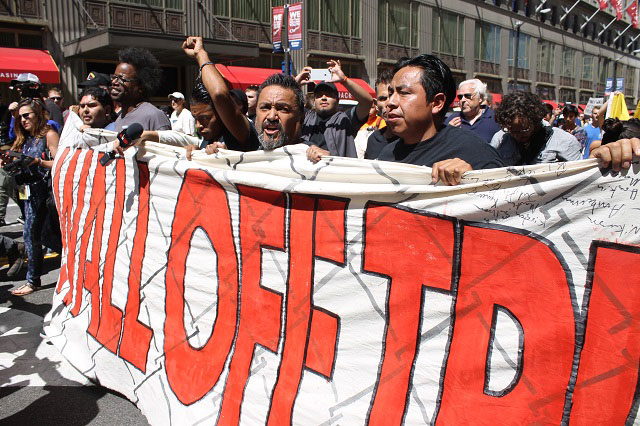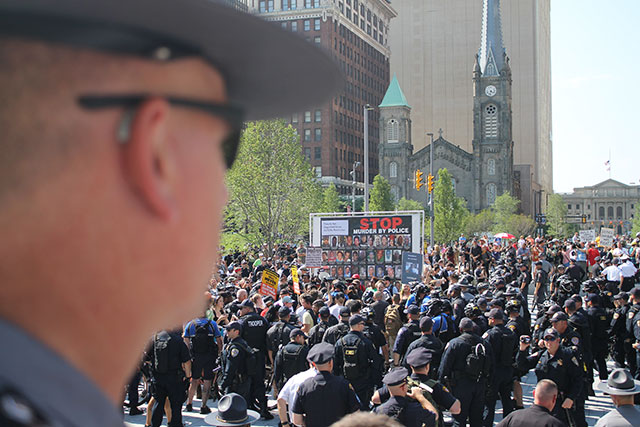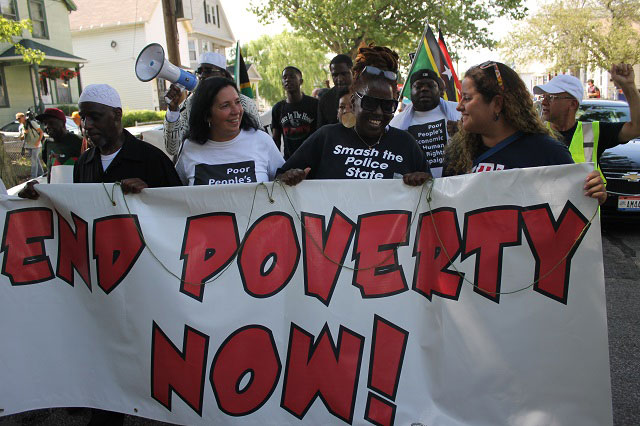
Part of the Series
Beyond the Sound Bites: Election 2016
Cleveland, Ohio—Throughout the Republican National Convention (RNC) in Cleveland, protesters have kept issues of poverty, racism and systemic police violence in the spotlight, even as Republicans attending the convention attempted to swerve the national debate on these issues toward the right.
On Wednesday, hundreds of immigrants rights protesters from across the U.S. erected a wall with several fence- and wall-like banners that stretched for several blocks outside the city’s Quicken Loans Arena, where the RNC is taking place.
The Wall Off Trump action was an effort to rebuff the Republican nominee’s promise to build a wall along the Mexican border, as well as his many bigoted comments against Mexican immigrants and other marginalized groups. The protesters first demonstrated at Cleveland’s Public Square and then marched from the square to the inside of the secure perimeter just outside the convention center.
“It’s important for us [undocumented people] to be standing out here. Otherwise we will continue to be pushed back into the dark spots of society,” Ivan Vargas, an undocumented activist with the Georgia Latino Alliance for Human Rights, told Truthout. “It’s also the [Republicans’] pushback on the Muslim community, the LGBTQ rights community, the Asian community. So it’s important not only for us but for other communities.”
However, the protesters outside the arena were not advocating uncritically for a Democratic win. Vargas and other immigrants rights activists expressed dissatisfaction not only with Trump’s campaign promises and the Republican Party’s immigration agenda but also with former Secretary of State Hillary Clinton’s public comments on immigration and the Obama administration’s current deportation policies.
“Just because [we get] a president that is African American or a Democrat does not mean that things will change,” Vargas told Truthout. “We believe that President Obama has been doing what Trump calls for. He has been taking part in some of the policies that Trump is spitting out there, but he has just been a little bit more moderate in what he says.”
Still, Vargas says, among the leading candidates, Trump is the larger threat. “While I don’t think that either candidate would be ideal for this country at this time, we definitely don’t need someone like Trump,” he said.
Activist groups including Mijente, the Ruckus Society, Iraq Veterans Against the War, Greenpeace, CODEPINK and others took part in the Wall Off Trump demonstration Wednesday, issuing a call to “wall off” the Republican Party’s racist politics of hate and fear.
“Today, we are drawing a line in the sand to demand respect for our communities and to ask for folks who are on the sidelines, not knowing what they should do, to come and join us and start walling off hate in their communities, to start protecting their people because we as a community know the solutions,” Eva Cardenas of the Ruckus Society said. “No one else is going to do it for us.”
Police Activists Confront a Sea of Police
Throughout the week of the RNC, activists from across the U.S. kept the issue of systemic police violence against Black, Brown, Queer and Indigenous bodies at the forefront of their actions in Cleveland. Meanwhile, Republicans inside the convention used the slogan “Make America Safe Again” to underscore their unabashedly pro-police message, referencing the shooting of police officers in Dallas and Baton Rouge this month.

More than 5,500 police officers were assigned to control protests and crowds at the RNC, not only from the Cleveland Police Department (CPD) and other Ohio police departments but also from more than a dozen other agencies such as the FBI; the Secret Service; the Department of Homeland Security; the State Highway Patrol; and even police departments in Florida, Texas and Montana; among others. Police in Cleveland are on heightened alert in the aftermath of the recent shootings of police officers.
The CPD received a $50 million federal grant to fund additional personnel and equipment to control protests and crowds at the RNC. A heavy police presence has blanketed the city since well before the RNC got underway Monday. Downtown, police cluster on almost every street corner, and large numbers of CPD officers in body armor on bicycles patrol the streets and corral protesters.
A heavy police presence was also seen at several protests against racism, white supremacy and systemic police violence that took place throughout the week in Cleveland, as protesters expressed a need to continue to act in solidarity with the movement for Black lives after the shootings of police officers in Dallas, Texas, and Baton Rouge, Louisiana.
“It’s beautiful that these protests are continuing in the face of mighty efforts by the authorities to suffocate them by using the events in Dallas to try to change the subject from police getting away with murder to expressing sympathy for police officers, and even by trying to blame the protests for what happened in Dallas,” civil rights activist and public intellectual Cornel West, who was present at the protests, said.
On Wednesday, multiple protesters were arrested during a flag-burning demonstration at 4th Street and Prospect Avenue after a fight broke out between opposing demonstrators.
Additionally, hundreds of police descended on Cleveland’s Public Square Tuesday during a demonstration against police violence in which West joined the Revolutionary Communist Party to protest the Monday acquittal of a third police officer charged in the death of Freddie Gray. Religious demonstrators gathered on the other side of the square.
Police divided groups of protesters into quadrants using bicycles and hundreds of officers dressed in various combinations of body- and riot-gear — from tactical teams wearing shielded helmets and carrying backpacks containing rifles and tear gas launchers, to officers dressed in traditional uniforms. The police slowly displaced both left- and right-wing protesters from the square Tuesday by steadily encroaching on the demonstrators’ spaces until they were finally dispersed.

Earlier that afternoon, police with bikes pushed into a crowd of protesters and media (including these reporters) to protect prominent right-wing radio host Alex Jones after a scuffle broke out between him and members of the Industrial Workers of the World.
Brian Cummins, a Cleveland City Council member representing the 14th ward, told Truthout that the equipment purchased for use by the CPD and other agencies during RNC will stay in the city after the convention ends. If a procurement process for a set of equipment falls under $50,000, then the city council doesn’t need to approve the expenditure, Cummins said, which means council members aren’t always briefed about what has been procured that falls under this amount.
The equipment buildup is a troubling sign for many Cleveland residents and activists. The CPD is currently under federal monitoring after the Department of Justice’s Civil Rights Division found it had engaged in a pattern or practice of violating the constitutional rights of people of color and other vulnerable populations.
As RNC Delegates Enjoy Lavish Parties, Activists March to End Poverty
Local groups formed a coalition to host an End Poverty Now! rally and march on Cleveland’s East Side on Monday in hopes that visiting participants of the RNC would acknowledge the realities of the nation’s dispossessed. After a rally featuring a series of social justice speakers and artists, more than 100 protesters marched from the Cleveland Masonic Performing Arts Center roughly two miles downtown, flanked by police on bicycles.
“Until you’ve walked in my shoes, please don’t tell [homeless] people to get out of your face, because you don’t know [what it’s like],” said Joyce McFolley, who has lived in Cleveland for 13 years and was homeless for six months in 2010. She told Truthout she feels like the city’s leaders have made a disproportionate effort to cater to the Republican Party’s convention in comparison to their effort to help the city’s poor. “[City leaders] fix up downtown [for Republicans], but they need to come over to the hood. That’s where we need help at.”

According to 2016 research from the Brookings Institution, Cleveland is among the top 10 cities in the country in terms of its percentage of residents living in concentrated poverty. Hosting this year’s RNC has been estimated to bring the city between $200 million and $400 million, but many Cleveland residents won’t see these economic benefits. The largest recipients of convention-generated revenue are hotels. Some businesses that were expecting extra profit with the influx of 50,000 visitors are actually seeing a decrease in business if they are near the barricaded security zones.
Some locals said the RNC and the preparation and security measures leading up to it have only inconvenienced them as many have experienced longer commutes to work.
Moreover, many of those without homes were displaced to accommodate the RNC. According to 2011 figures from the Northeast Ohio Coalition for the Homeless, more than 23,000 people in Cuyahoga County were homeless. Brian Davis, the executive director of the Coalition, said the originally planned event zone for the convention was very broad and covered much of the city, displacing many people without homes.
“This is why we asked for a smaller event zone, and for the city’s homeless population to gain ‘resident’ status,” Davis told Truthout, referring to a recent lawsuit against the city by the American Civil Liberties Union.
At the end of June, U.S. District Judge James Gwin ruled that the original event zone was “unduly large,” and that restrictions on planned protests were unconstitutional. Even after the lawsuit succeeded and the size of the event zone was reduced, some homeless people said they were scared they would be stop-and-search targets, according to Davis.
Moreover, Cleveland police have been requesting that the city’s homeless population participate in surveillance leading up to the week of the RNC, asking for them to keep watch for any unfamiliar faces and report any suspicious behavior.
Meanwhile, resident McFolley said, poverty itself remains largely unaddressed.
“[City leaders] need to come where people are really, really living their struggle,” McFolley said. “A human being has a heart made of flesh, not made of stone, and what they do to these homeless people — you can’t have a heart, you can’t be human.”
Join us in defending the truth before it’s too late
The future of independent journalism is uncertain, and the consequences of losing it are too grave to ignore. To ensure Truthout remains safe, strong, and free, we need to raise $43,000 in the next 6 days. Every dollar raised goes directly toward the costs of producing news you can trust.
Please give what you can — because by supporting us with a tax-deductible donation, you’re not just preserving a source of news, you’re helping to safeguard what’s left of our democracy.